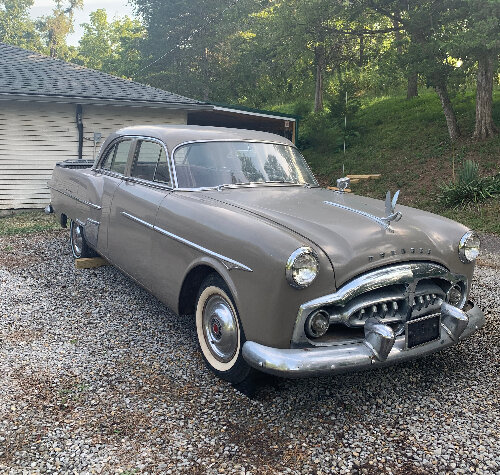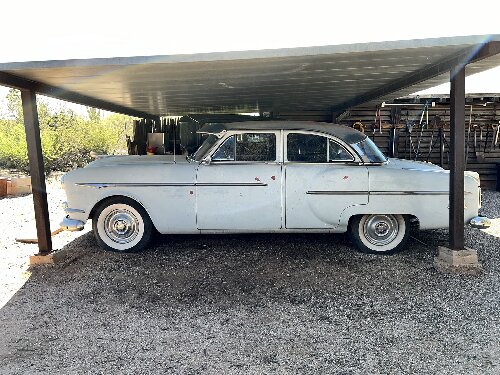|
Re: Intake manifold crack in heat riser
|
||||
|---|---|---|---|---|
|
Home away from home

|
Or just have someone braze it.
Posted on: 2010/8/30 21:43
|
|||
|
||||
|
Re: Intake manifold crack in heat riser
|
||||
|---|---|---|---|---|
|
Webmaster
|
I think if you used a NI brazing rod, that would work nicely.
Posted on: 2010/8/30 22:41
|
|||
|
-BigKev
1954 Packard Clipper Deluxe Touring Sedan -> Registry | Project Blog 1937 Packard 115-C Convertible Coupe -> Registry | Project Blog |
||||
|
||||
|
Re: Intake manifold crack in heat riser
|
||||
|---|---|---|---|---|
|
Home away from home
|
JB weld uses epoxy for the adhesive that holds everything together. I have used it successfully on several engine applications, but never on an uncooled exhaust system. The temperature in that manifold area most likely exceeds the 500 degree limit. If it was water cooled such as on the block or head JB weld would probably work. I suggest cast iron welding and then surfacing both manifolds to correct any warpage.
Posted on: 2010/8/31 9:49
|
|||
|
Fred Puhn

|
||||
|
||||
|
Re: Intake manifold crack in heat riser
|
||||
|---|---|---|---|---|
|
Home away from home

|
First choice, replace the manifold.
Second choice, have it welded or brazed. This is not very difficult or expensive. There should be lots of expert welders in Germany who can do such a simple job. Ask around your old car pals for someone who does this kind of work on old cars. Any other solution is temporary or an undesirable hack.
Posted on: 2010/8/31 12:23
|
|||
|
||||
|
Re: Intake manifold crack in heat riser
|
||||
|---|---|---|---|---|
|
Forum Ambassador

|
I hesitate to disagree with Rusty who knows his stuff, but I don't think that a good weld job on a cast iron part subject to considerable thermal expansion and contraction is "a simple job". I've seen it done a number of times by a shop that specializes in this work; the just the gradual heating up in a furnace, welding while HOT, and then the controlled cooling over a period of days is anything but simple. Maybe there are other methods that I'm not familiar with.
Posted on: 2010/8/31 15:44
|
|||
|
||||
|
Re: Intake manifold crack in heat riser
|
||||
|---|---|---|---|---|
|
Home away from home

|
Kurt my friend who is helping me with this project is a professional welder, and said it could 'possibly' be welded. He hasn't seen the part/crack yet though... I will at least clean the manifold up and show it to a few people here, and see what they think. I don't think JB weld would hold up in an exhaust manifold either.
If I understand correctly the difference between brazing and welding, then brazing is at a lower temperature and would just fill the crack (like solder, or on a radiator tank), where as welding really is welding, which is much more structural and would require a lot more temp and energy....
Posted on: 2010/8/31 16:13
|
|||
|
||||
|
Re: Intake manifold crack in heat riser
|
||||
|---|---|---|---|---|
|
Webmaster
|
You are correct. Brazing doesnt fuse the base metals together.
Posted on: 2010/8/31 16:40
|
|||
|
-BigKev
1954 Packard Clipper Deluxe Touring Sedan -> Registry | Project Blog 1937 Packard 115-C Convertible Coupe -> Registry | Project Blog |
||||
|
||||
|
Re: Intake manifold crack in heat riser
|
||||
|---|---|---|---|---|
|
Home away from home

|
I have repaired cracked exhaust manifolds both by brazing and by welding. All worked perfectly, none of the welds failed.
It did not take that long to preheat the metal. Maybe 15 minutes or half an hour. Often the repair was done in a country shop heated by a wood stove, and the most primitive welding equipment. I would put the manifold on the wood stove and build a fence of fire bricks around it and leave it to warm up, then heat up the manifold with the acetylene torch, braze it up, cover with a lid of fire bricks and go away. The cool down did not take that long either, I would leave them for a few hours or overnight and go do something else. My concern would be that the manifold would eventually burn out again. Of course this would take many years. I would have to look at the job and figure out if it was possible to put a piece of metal on the inside, out of sight, to protect it. Brazing would be easier and less likely to cause heat stress or warping but would not stand up to as much heat. It is plenty good enough for a normal exhaust manifold but if those burn out spots are caused by some kind of concentrated exhaust pressure like a cutting torch it could be tense. Another method is to drill out the holes and fit round plugs cut from a scrap exhaust manifold, and braze them in place. This might be better than simply brazing or welding the holes. It depends how bad they are. There is another excellent method of repair used to fix cracked engine blocks etc. That is to drill a hole and screw in a pipe plug. Then cut the pipe plug off flush and dress it with a file or grinder. Such a repair can be completely invisible. If you want to be pernickity, sandblasting the repaired area gives it the rough cast iron look. Long cracks can be repaired with a series of overlapping plugs. This has been a standard repair method for many, many years. This would completely avoid the problem of welding or brazing and make an even more secure repair. The only question is whether the metal is thick enough. Now that I think about it the pipe plug method would be the best and easiest way to fix those holes and the longest lasting or most permanent repair. Of course this is just speculation, without actually seeing the job it is impossible to say for sure.
Posted on: 2010/8/31 18:59
|
|||
|
||||
|
Re: Intake manifold crack in heat riser
|
||||
|---|---|---|---|---|
|
Home away from home

|
Rusty...I am completely insulted by your comment "Any other solution is temporary or an undesirable hack." Are you implying that using JB weld is only for amateurs who don't know what they are doing? Hrumph!
I'm going back to my car to finish sanding my 2x4 frame...maybe add a classy stain to it too. You'll be sorry when you see how good it comes out! LOL...Obviously I'm just kidding. I was thinking more along the lines of a repair to get him going again until he could source a new manifold. In my own defense, I also offered a high temp alternative to the JB Weld. Of course, Rusty's suggestions, especially the plugs seem the best to me. Best to do it once and do it right!
Posted on: 2010/8/31 20:16
|
|||
|
[url=h
|
||||
|
||||








